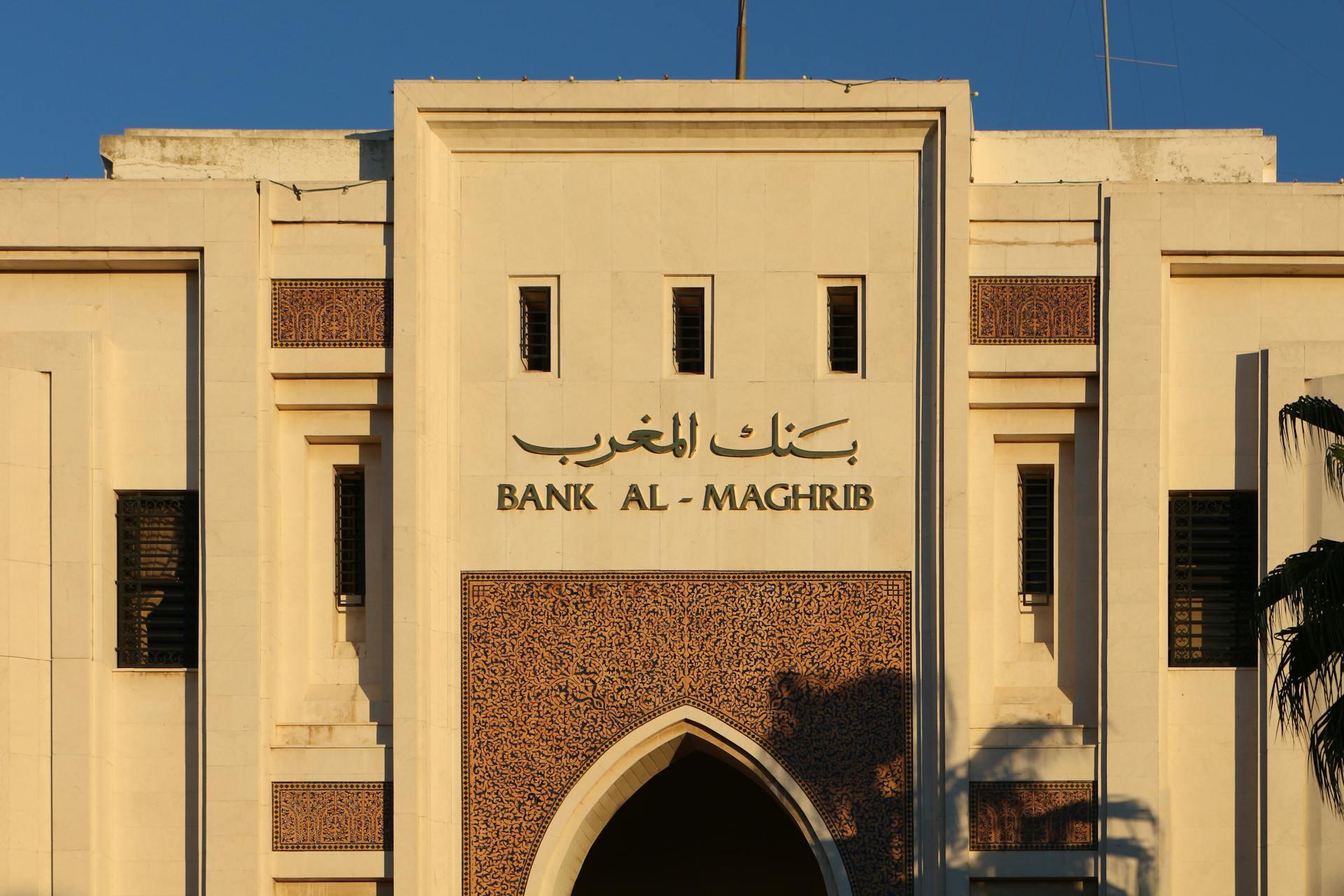
The New York State Department of Financial Services (DFS) is a crucial agency that oversees the financial services industry in the state. It was created in 2011 as a result of the Dodd-Frank Wall Street Reform and Consumer Protection Act.
The DFS has a broad range of responsibilities, including regulating and supervising banks, insurance companies, and other financial institutions. It also enforces laws and regulations to protect consumers and maintain financial stability.
The DFS is led by a superintendent who is appointed by the governor and confirmed by the state legislature. The superintendent serves as the chief regulator and enforcer of the DFS's mission and goals.
Leadership and Organization
The New York State Department of Financial Services has had its fair share of leadership changes over the years. Benjamin M. Lawsky was unanimously confirmed as the first Superintendent of Financial Services in 2011.
Lawsky also served as Acting Superintendent of Banks from May 24, 2011, until October 3, 2011. This was a crucial role in consolidating the state's financial regulatory agencies.

James J. Wrynn, a former Superintendent of Insurance, was appointed as Deputy Superintendent of Financial Services but left the department in 2012 to become a partner at a law firm.
Adrienne A. Harris was appointed by Governor Kathy Hochul in August 2021 and was confirmed by the New York State Legislature in January 2022. Harris brings a wealth of experience to the role, having previously served as Senior Advisor to the Deputy Treasury Secretary.
Regulations and Fines
Deutsche Bank was fined $425 million by the NYSDFS in 2017 for violating New York's anti-money laundering laws.
The NYSDFS has strict regulations for financial institutions operating in New York. Starting from January 1, 2017, these institutions are required to comply with anti-terrorism transaction monitoring and filtering program regulations.
To fulfill their responsibilities, financial institutions must establish a risk-based Anti-Money Laundering program. This program includes several key obligations, such as:
- Examination of customer transactions with a risk-based approach.
- Compliance with applicable Bank Secrecy Act and AML laws and regulations.
- Creating an enhanced AML control program to detect organized crime.
- Checking customers on the Office of Foreign Assets Control (OFAC) sanction lists.
- Reporting detecting money-laundering activities to authorized units.
- Monitoring customer transactions to combat money laundering and terrorist financing.
- Employing an AML compliance officer or money laundering reporting officer.
These regulations are in place to prevent financial institutions from being used for illicit activities.
Deutsche Bank Fined

Deutsche Bank was fined $425 million by the NYSDFS for violating New York's anti-money laundering laws.
This fine was a result of a specific incident that occurred on January 30, 2017, when the NYSDFS took action against Deutsche Bank.
Attention to NYSDFS Supervised Orgs
If you're a financial institution operating under the New York Banking Law, you need to be aware of the regulations set by the New York Department of Financial Services (NYDFS). Starting from January 1, 2017, these institutions are obligated to comply with anti-terrorism transaction monitoring and filtering program regulations.
You'll need to establish a risk-based Anti-Money Laundering (AML) program to fulfill your responsibilities. This means conducting examinations of customer transactions with a risk-based approach.
Compliance with applicable Bank Secrecy Act and AML laws and regulations is also a must. You'll need to create an enhanced AML control program to detect organized crime, such as money laundering and terrorist financing.
Readers also liked: Nonprofit Debt Consolidation near Me

Here are the key obligations of businesses under NYSDFS supervision:
- Examination of customer transactions with a risk-based approach.
- Compliance with applicable Bank Secrecy Act and AML laws and regulations.
- Creating an enhanced AML control program to detect organized crime, such as money laundering and terrorist financing.
- Checking customers on the Office of Foreign Assets Control (OFAC) sanction lists.
- Reporting detecting money-laundering activities to authorized units.
- Monitoring customer transactions to combat money laundering and terrorist financing.
- Employing an AML compliance officer or money laundering reporting officer.
These regulations were developed to prevent and detect financial crimes, and non-compliance can result in severe fines and penalties.
Services and Providers
The DFS oversees service contract providers in New York State. These providers must be licensed and regulated to operate.
If you're looking for a list of currently licensed service contract providers, you can check the DFS's website at Currently Registered Service Contract Providers.
You might like: Truist Bank Customer Service Phone Number 24 7
DFS Structure and Divisions
The New York State Department of Financial Services (DFS) is a well-structured organization with separate divisions that deal with specific sectors of the financial services industry. These divisions work together to supervise a range of sectors.
The DFS has departments that manage industry-wide issues, such as the Consumer Protection and Financial Enforcement Division (CPFED), the Climate Division, and the Cybersecurity division, to protect consumers and industries from cyber threats. These divisions are crucial in maintaining the stability and security of the financial system.
Worth a look: Mortgage Lending Industry

Here are some of the sectors that the DFS supervises:
- Banks and Credit Unions: This includes commercial, community, regional, and national institutions operating within the state, and trust companies.
- Consumer Credit Reporting Agencies: Companies that gather data on individuals' credit history are in possession of sensitive information that needs to be protected.
- Health Insurers: This includes health maintenance organizations and continuing care retirement communities.
- Mortgage Bankers, Brokers and Services: Mortgage companies and providers, including originators, must be registered with and licensed by the NYDFS.
- Service Contract Providers: The guarantors of work carried out by contractors have an obligation to cover costs should the work result in damage to property.
The DFS has five main divisions: the Insurance Division, the Banking Division, the Financial Frauds and Consumer Protection Division, the Capital Markets Division, and the Real Estate Division.
Creation of Financial Services Department
The DFS was created in 2011 through the consolidation of the New York State Banking Department and the New York State Insurance Department. This consolidation aimed to streamline the regulation of financial institutions and insurance companies in the state.
The DFS oversees a vast network of institutions, covering about 1,200 lenders and institutions with assets totaling $3.3 trillion as of December 31, 2021. It also regulates 1,700 insurance companies with assets valued at $5.5 trillion during the same period.
The DFS is headquartered in lower Manhattan, a strategic location that allows for easy access to major financial hubs. It has additional offices around the state, including in Albany, Buffalo, Garden City, Oneonta, and Syracuse.
For more insights, see: Funds in Savings and Loan Institutions Are Protected by
DFS Divisions

The New York Department of Financial Services (DFS) has several divisions that oversee specific sectors of the financial services industry. These divisions work together to supervise a range of sectors, including banks and credit unions.
The DFS has departments that manage industry-wide issues, such as the Consumer Protection and Financial Enforcement Division (CPFED), which protects consumers and industries from cyber threats. This division is crucial in today's digital age, where sensitive information is at risk of being compromised.
The DFS also has divisions that focus on specific sectors, such as the Insurance Division, which oversees health insurers, health maintenance organizations, and continuing care retirement communities. These organizations are required to register with the NYDFS and undergo financial and market conduct examinations.
The DFS has five main divisions: the Insurance Division, the Banking Division, the Financial Frauds and Consumer Protection Division, the Capital Markets Division, and the Real Estate Division. Each of these divisions plays a critical role in ensuring the stability and integrity of the financial services industry in New York State.
See what others are reading: Agriculture Risk Protection Act of 2000

Here is a list of the sectors supervised by the DFS divisions:
- Banks and Credit Unions: commercial, community, regional, and national institutions operating within the state, and trust companies.
- Consumer Credit Reporting Agencies: companies that gather data on individuals' credit history.
- Health Insurers: health maintenance organizations and continuing care retirement communities.
- Mortgage Bankers, Brokers and Services: mortgage companies and providers, including originators.
- Service Contract Providers: guarantors of work carried out by contractors such as electricians, motor mechanics, and plumbers.
Missions and Objectives
The New York State Department of Financial Services (NYSDFS) has a clear mission to maintain stability within the financial industry.
Their main goal is to oversee financial institutions to ensure they are operating safely and soundly. This includes preventing financial fraud and educating consumers on financial products and services.
To promote the growth of the financial industry in New York, NYSDFS encourages financial institutions to uphold high standards of public responsibility, business practice, conduct, and ethics. This helps ensure reliability and soundness.
NYSDFS also implements regulations to combat financial crimes and conducts audits to ensure compliance with regulations. They take a proactive approach to maintaining the integrity of the financial system.
Here are the specific missions of NYSDFS:
- Overseeing financial institutions to maintain stability within the industry
- Preventing financial fraud and educating consumers on financial products and services
- Promoting the growth of the financial industry in New York while prioritizing the safety of consumers and their providers
- Encouraging financial institutions to uphold high standards of public responsibility, business practice, conduct, and ethics to ensure reliability and soundness
- Implementing regulations to combat financial crimes
- Conducting audits to ensure compliance with regulations
Cybersecurity and Regulation
The NYDFS Cybersecurity Regulation is a set of rules designed to improve cybersecurity practices in financial organizations operating in New York. It mandates that organizations establish a comprehensive cybersecurity policy and designate a Chief Information Security Officer to actively manage cybersecurity risks.

The regulation requires organizations to conduct regular cybersecurity risk assessments and implement adequate cybersecurity controls to mitigate identified risks. This helps to ensure that organizations are continuously monitoring potential threats and taking necessary measures to prevent cyber attacks.
The regulation is divided into four phases, with each phase outlining specific cybersecurity requirements that covered organizations must meet. The first phase, which went into effect on February 15, 2018, required covered organizations to develop a comprehensive cybersecurity policy that included an incident response plan with data breach notifications within 72 hours.
You might like: Bank Regulation in the United States
Bitcoin
In August 2013, Forbes magazine reported that the department initiated an investigation into bitcoin by issuing subpoenas to several companies and investors.
The department's investigation into bitcoin was a significant event, marking one of the first times a government agency had taken a close look at the cryptocurrency.
On July 17, 2014, the department released details on a proposed BitLicense, which places regulations on any company or person that uses cryptocurrencies residing in New York.
The proposed regulations were officially published in the New York State Register on July 23, starting a 45-day comment period.
A revised proposal notice was published on February 25, 2015, beginning another 30-day comment period, giving stakeholders more time to review and provide feedback.
For more insights, see: Pay Day Loan App
Nydfs Cybersecurity Regulation

The NYDFS Cybersecurity Regulation is a set of rules designed to improve cybersecurity practices in financial organizations operating in New York.
The regulation was announced on February 16th, 2017, and went into effect on March 1, 2017, after two rounds of feedback from the industry and the public.
Covered organizations must establish a comprehensive cybersecurity policy and designate a Chief Information Security Officer to actively manage cybersecurity risks and safeguard their clients' sensitive information.
The regulation is divided into four phases, with each phase outlining specific cybersecurity requirements that covered organizations must meet.
The first phase of the regulation went into effect on February 15, 2018, and required covered organizations to develop a comprehensive cybersecurity policy that included an incident response plan with data breach notifications within 72 hours.
Covered institutions must continuously evaluate vulnerabilities and develop proactive responses to threats, as mandated by the second phase of the regulation, which went into effect on March 1, 2018.
A different take: Regulation D (FRB)

Phase three of the regulation, which went into effect on September 3, 2018, requires covered institutions to have a comprehensive cybersecurity program in place that contains several key elements, including an audit trail that reflects threat detection and response activities.
Covered institutions are required to establish policies concerning third parties that may be granted access to systems and files governed by the regulation, which became effective on March 1, 2019.
This regulation is a critical step in creating a more secure financial industry in New York, by enforcing the implementation of comprehensive cybersecurity policies and risk management practices.
On a similar theme: What Does Workmen Compensation Insurance Cover
Frequently Asked Questions
Who is covered by NYDFS?
The NYDFS regulates the financial condition and market conduct of life insurance companies, savings banks, public pension funds, fraternal benefit societies, and more. If you're unsure if your insurance provider is covered, check our website for a comprehensive list.
How do I contact the Financial Services Department of New York?
You can contact the Financial Services Department of New York by visiting their website at www.dfs.ny.gov or by calling (800) 342-3736 (toll-free) or (212) 480-6400 (direct).
Sources
- https://en.wikipedia.org/wiki/New_York_State_Department_of_Financial_Services
- https://www.dowjones.com/professional/risk/glossary/regulatory-bodies/ny-state-dept-financial-services/
- https://www.sanctionscanner.com/knowledge-base/new-york-state-department-of-financial-services-nysdfs-62
- https://content.naic.org/es/node/5576
- https://www.lexology.com/library/detail.aspx
Featured Images: pexels.com


